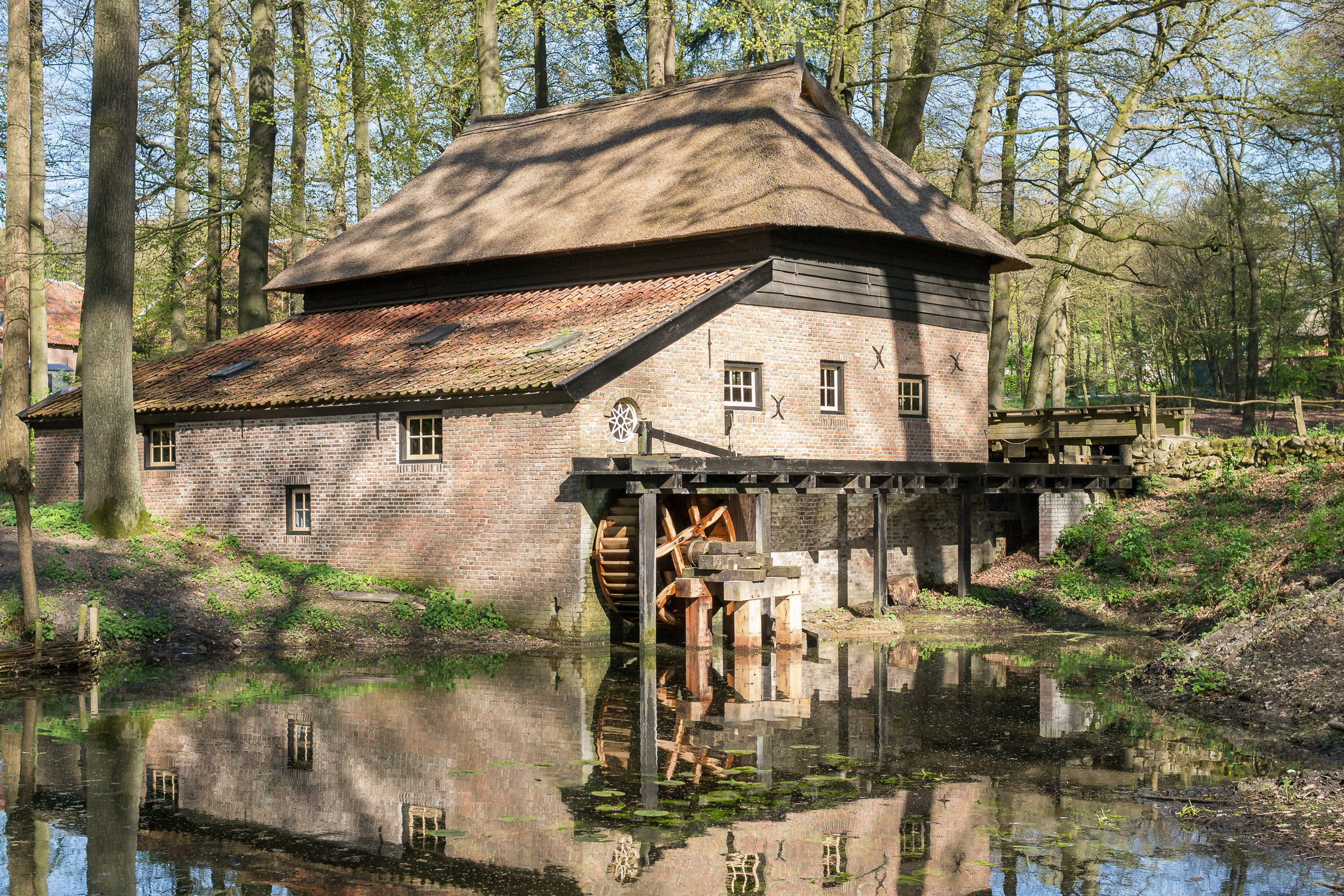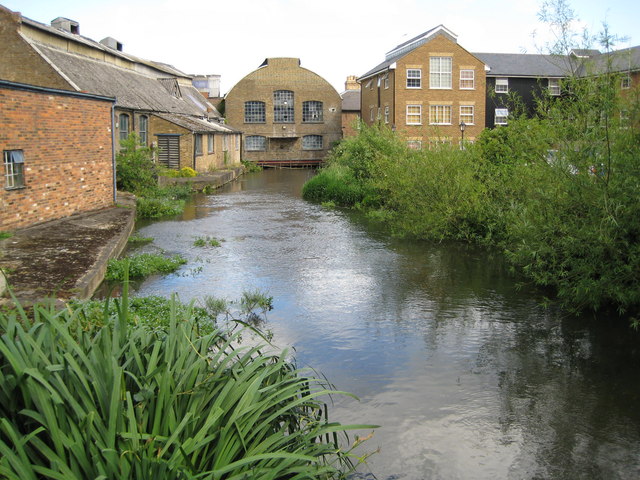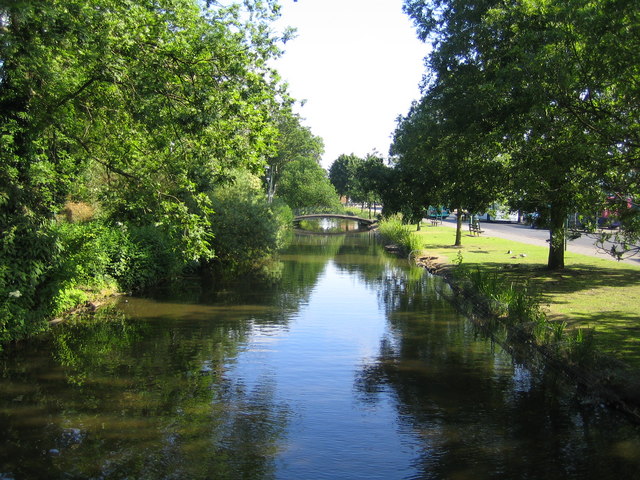|
Frogmore Paper Mill
Frogmore Paper Mill is a working paper mill situated in Apsley, Hertfordshire, near Hemel Hempstead. The mill is on an island in the River Gade, which forms part of the Grand Union Canal. It is the oldest mechanical paper mill in the world. History There are no surviving records documenting when a mill was first built on the current site, but it is recorded as being a corn mill in 1086 in the Domesday Book. In 1289, the mill was used for fulling; removing oil and other impurities from woolen cloth. It returned to milling grain, then became a fulling mill once more, then finally it become a paper mill by 1774. The world's first mechanised paper machine was installed at Frogmore Mill in 1803 funded by Sealy and Henry Fourdrinier and engineered by Bryan Donkin, based upon a design by Nicolas-Louis Robert. This machine allowed continuous automated production of paper rolls. Unfortunately the £60,000 costs of developing the paper machines meant that the Fourdrinier brothers were b ... [...More Info...] [...Related Items...] OR: [Wikipedia] [Google] [Baidu] |
Paper Mill
A paper mill is a factory devoted to making paper from vegetable fibres such as wood pulp, old rags, and other ingredients. Prior to the invention and adoption of the Fourdrinier machine and other types of paper machine that use an endless belt, all paper in a paper mill was made by hand, one sheet at a time, by specialized laborers. History Historical investigations into the origin of the paper mill are complicated by differing definitions and loose terminology from modern authors: Many modern scholars use the term to refer indiscriminately to all kinds of mills, whether powered by humans, by animals or by water. Their propensity to refer to any ancient paper manufacturing center as a "mill", without further specifying its exact power source, has increased the difficulty of identifying the particularly efficient and historically important water-powered type. Human and animal-powered mills The use of human and animal powered mills was known to Muslim and Chinese paperma ... [...More Info...] [...Related Items...] OR: [Wikipedia] [Google] [Baidu] |
Apsley, Hertfordshire
Apsley was a 19th-century mill village in the county of Hertfordshire, England. It is a historic industrial site situated in a valley of the Chiltern Hills. It is positioned below the confluence of two permanent rivers, the Gade and Bulbourne. In an area of little surface water this was an obvious site for the location of water mills serving local agriculture and from the early 19th century became an important centre for papermaking. Today it is a suburb of the larger town of Hemel Hempstead. Recent (2011–) rapid building around the canal area has seen a large influx of London commuters, largely from the software and business communities. At the 2011 Census the village was included in the Dacorum Ward of Apsley and Corner Hall. Origin of the name The name Apsley dates from the Anglo-Saxon period and means ''aspen wood''. History 1798-1999 It was the construction of the trunk canal (later to be called the Grand Union Canal) between London and the Midlands through the valley ... [...More Info...] [...Related Items...] OR: [Wikipedia] [Google] [Baidu] |
Hemel Hempstead
Hemel Hempstead () is a town in the Dacorum district in Hertfordshire, England, northwest of London, which is part of the Greater London Urban Area. The population at the 2011 census was 97,500. Developed after the Second World War as a new town, it has existed since the 8th century and was granted its town charter by Henry VIII in 1539. Nearby towns are Watford, St Albans and Berkhamsted. History Origin of the name The settlement was called by the name Henamsted or Hean-Hempsted in Anglo-Saxon times and in William the Conqueror's time by the name of Hemel-Amstede. The name is referred to in the Domesday Book as Hamelamestede, but in later centuries it became Hamelhamsted, and, possibly, Hemlamstede. In Old English, ''-stead'' or ''-stede'' simply meant "place" (reflected in German ''Stadt'' and Dutch ''stede'' or ''stad'', meaning "city" or "town"), such as the site of a building or pasture, as in clearing in the woods, and this suffix is used in the names of other E ... [...More Info...] [...Related Items...] OR: [Wikipedia] [Google] [Baidu] |
River Gade
The River Gade is a river running almost entirely through Hertfordshire. It rises from a spring in the chalk of the Chiltern Hills at Dagnall, Buckinghamshire and flows through Hemel Hempstead, Kings Langley, then along the west side of Watford through Cassiobury Park. After passing Croxley Green it reaches Rickmansworth, where it joins the River Colne. For its whole course the Gade is unnavigable. Its principal tributary is the River Bulbourne which joins it at Two Waters, just below Hemel Hempstead. The river was once used to power water mills, such as those at Water End, Cassiobury Park and Two Waters as well as powering the John Dickinson paper mills at Apsley and Croxley. It supported the farming of watercress at Cassiobury Park, Water End, the Grade 2 listeJellicoe Water Gardensand Two Waters until water was diverted from the river in 1947 to supply the growing new town of Hemel Hempstead. Below Hemel Hempstead it runs alongside and sometimes forms part of the ... [...More Info...] [...Related Items...] OR: [Wikipedia] [Google] [Baidu] |
Grand Union Canal
The Grand Union Canal in England is part of the British canal system. It is the principal navigable waterway between London and the Midlands. Starting in London, one arm runs to Leicester and another ends in Birmingham, with the latter stretching for with 166 locks from London. The Birmingham line has a number of short branches to places including Slough, Aylesbury, Wendover, and Northampton. The Leicester line has two short arms of its own, to Market Harborough and Welford. It has links with other canals and navigable waterways, including the River Thames, the Regent's Canal, the River Nene and River Soar, the Oxford Canal, the Stratford-upon-Avon Canal, the Digbeth Branch Canal and the Birmingham and Fazeley Canal. The canal south of Braunston to the River Thames at Brentford in London is the original Grand Junction Canal. At Braunston the latter met the Oxford Canal linking back to the Thames to the south and to Coventry to the north via the Coventry Canal. "Grand ... [...More Info...] [...Related Items...] OR: [Wikipedia] [Google] [Baidu] |
Domesday Book
Domesday Book () – the Middle English spelling of "Doomsday Book" – is a manuscript record of the "Great Survey" of much of England and parts of Wales completed in 1086 by order of King William I, known as William the Conqueror. The manuscript was originally known by the Latin name ''Liber de Wintonia'', meaning "Book of Winchester", where it was originally kept in the royal treasury. The '' Anglo-Saxon Chronicle'' states that in 1085 the king sent his agents to survey every shire in England, to list his holdings and dues owed to him. Written in Medieval Latin, it was highly abbreviated and included some vernacular native terms without Latin equivalents. The survey's main purpose was to record the annual value of every piece of landed property to its lord, and the resources in land, manpower, and livestock from which the value derived. The name "Domesday Book" came into use in the 12th century. Richard FitzNeal wrote in the ''Dialogus de Scaccario'' ( 1179) that the book ... [...More Info...] [...Related Items...] OR: [Wikipedia] [Google] [Baidu] |
Fulling
Fulling, also known as felting, tucking or walking ( Scots: ''waukin'', hence often spelled waulking in Scottish English), is a step in woollen clothmaking which involves the cleansing of woven or knitted cloth (particularly wool) to eliminate (lanoline) oils, dirt, and other impurities, and to make it shrink by friction and pressure. The work delivers a smooth, tightly finished fabric that is isolating and water repellent. Well known example are duffel cloth, first produced in Flanders in the 14th century and loden, produced in Austria from the 16th century on. The practice to do this by hand or feet died out with the introduction of machines during the industrial revolution. Process Fulling involves two processes: scouring and milling (thickening). Originally, fulling was carried out by the pounding of the woollen cloth with a club, or the fuller's feet or hands. In Scottish Gaelic tradition, this process was accompanied by waulking songs, which women sang to set the ... [...More Info...] [...Related Items...] OR: [Wikipedia] [Google] [Baidu] |
Sealy Fourdrinier
Sealy Fourdrinier (9 October 1773 – 1847) was an English paper-making entrepreneur. He was born the son of paper maker and stationer Henry Fourdrinier and grandson of the engraver Paul Fourdrinier (1698-1758), who were of Huguenot descent. His brother was Henry Fourdrinier, his later partner in business. Around the end of the 18th century Sealy and his brother were approached by John Gamble and Leger Didot, who were seeking financial support to develop an automatic paper making machine developed in Paris by Louis-Nicolas Robert, an employee of Didot. In 1801–02 the Fourdriniers entrusted engineer Bryan Donkin (then working with John Hall) with the development of Robert's model into a prototype continuous paper-making machine. The world's first production machine was installed at Frogmore Paper Mill in Apsley, Hertfordshire in 1803 and a second, much improved and larger machine installed the following year. By 1810 eighteen machines had been installed at various mills. The co ... [...More Info...] [...Related Items...] OR: [Wikipedia] [Google] [Baidu] |
Henry Fourdrinier
Henry Fourdrinier (11 February 1766 – 3 September 1854) was a British paper-making entrepreneur. He was born in 1766, the son of paper maker and stationer Henry Fourdrinier, and grandson of the engraver Paul Fourdrinier, 1698–1758, sometimes mistakenly called Pierre Fourdrinier. With his brother, Sealy, he commissioned the development of the Fourdrinier machine, a papermaking machine that produced continuous rolls of paper. The machine is an industrialised version of the historical hand paper-making method, which could not satisfy the demands of developing modern society for large quantities of printing and writing materials. A patent was granted on 24 July 1806, for a machine that could make a long continuous web of paper. This had the dual advantage of considerably higher productivity plus production in roll form, for applications such as wallpaper printing. The range of cut paper sizes was also extended as it was not limited by the frame or deckle size of hand made paper ... [...More Info...] [...Related Items...] OR: [Wikipedia] [Google] [Baidu] |
Bryan Donkin
Bryan Donkin FRS FRAS (22 March 1768 – 27 February 1855) developed the first paper making machine and created the world's first commercial canning factory. These were the basis for large industries that continue to flourish today. Bryan Donkin was involved with Thomas Telford's Caledonian Canal, Marc and Isambard Brunel's Thames Tunnel, and Charles Babbage's computer. He was an advisor to the government and held in high esteem by his peers. Early life Raised in Sandhoe, Northumberland, his father was a surveyor and land agent. Donkin initially began work in the same business, and worked from September 1789 to February 1791 as bailiff at Knole House and estate for the Duke of Dorset. Career While working for the Duke of Dorset, Donkin consulted the engineer John Smeaton, an acquaintance of his father, as to how he could become an engineer. At Smeaton's advice in 1792 he apprenticed himself to John Hall in Dartford, Kent, who had founded the Dartford Iron Works (later J & ... [...More Info...] [...Related Items...] OR: [Wikipedia] [Google] [Baidu] |
Grand Junction Canal
The Grand Junction Canal is a canal in England from Braunston in Northamptonshire to the River Thames at Brentford, with a number of branches. The mainline was built between 1793 and 1805, to improve the route from the Midlands to London, by-passing the upper reaches of the River Thames near Oxford, thus shortening the journey. In 1927 the canal was bought by the Regent's Canal Company and, since 1 January 1929, has formed the southern half of the Grand Union Main Line from London to Birmingham. The canal is now much used by leisure traffic. Isambard Kingdom Brunel's last major undertaking was the compact Three Bridges, London, on the canal. Work began in 1856, and was completed in 1859. The three bridges are an overlapping arrangement allowing the routes of the Grand Junction Canal, Great Western and Brentford Railway, and Windmill Lane to cross. History Need By 1790, an extensive network of canals was in place, or under construction, in the Midlands. However, the on ... [...More Info...] [...Related Items...] OR: [Wikipedia] [Google] [Baidu] |
Heritage Lottery Fund
The National Lottery Heritage Fund, formerly the Heritage Lottery Fund (HLF), distributes a share of National Lottery funding, supporting a wide range of heritage projects across the United Kingdom. History The fund's predecessor bodies were the National Land Fund, established in 1946, and the National Heritage Memorial Fund, established in 1980. The current body was established as the "Heritage Lottery Fund" in 1994. It was re-branded as the National Lottery Heritage Fund in January 2019. Activities The fund's income comes from the National Lottery which is managed by Camelot Group. Its objectives are "to conserve the UK's diverse heritage, to encourage people to be involved in heritage and to widen access and learning". As of 2019, it had awarded £7.9 billion to 43,000 projects. In 2006, the National Lottery Heritage Fund launched the Parks for People program with the aim to revitalize historic parks and cemeteries. From 2006 to 2021, the Fund had granted £254million ... [...More Info...] [...Related Items...] OR: [Wikipedia] [Google] [Baidu] |










